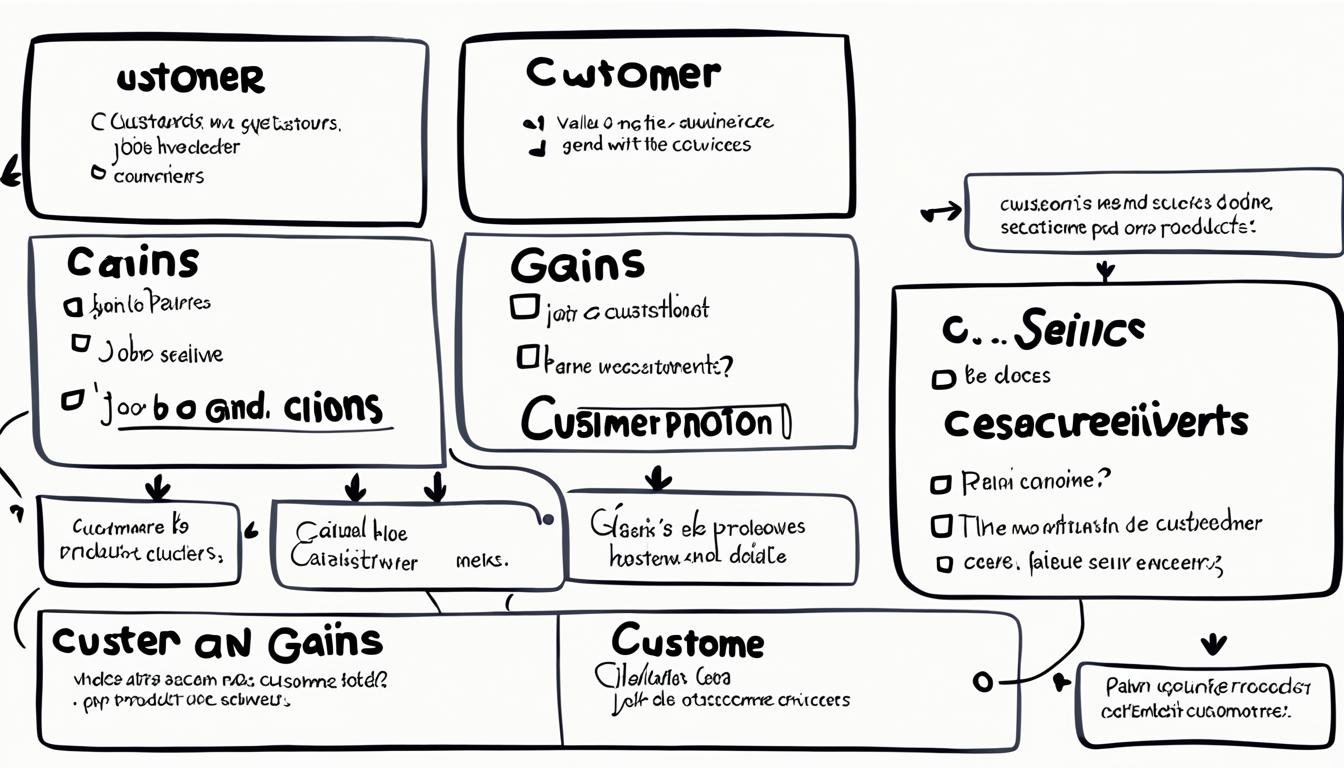Value Proposition Canvas: Creating Compelling Offers
In today’s competitive world, how do you make your product or service stand out? The key is in a strong value proposition. But what is it, and how does it help your business grow? Let’s dive into the Value Proposition Canvas and learn how to make offers that grab attention.
Key Takeaways
- A value proposition clearly shares the unique benefits and value your product or service offers to customers.
- Creating a compelling value proposition is key to standing out and connecting with your audience.
- Tools like the Value Proposition Canvas, Harvard Business School’s essential questions, and Steve Blank’s formula can help craft a strong value proposition.
- Focus on customer benefits, emotional drivers, and unique approaches for a successful value proposition.
- Companies like Slack and Bloom & Wild have seen big success with strong value propositions.
What is a Value Proposition?
A value proposition is a statement that clearly shares the unique benefits and value your product or service offers to customers. It tells customers what makes your offering different from others and why they should pick it. A strong value proposition is key for businesses to stand out and show potential buyers that your product or service is the best fit for their needs.
Defining a Value Proposition
A value proposition is a brief statement that lists the specific benefits and value your company’s product or service gives to its target customers. It should spotlight the unique value proposition – the special features, benefits, and advantages that make your offering unique in the market. A value proposition statement clearly shows how your product or service solves a problem or makes the customer’s life better.
Importance of a Value Proposition
- A strong value proposition is a key competitive advantage that sets your business apart from rivals.
- It helps ensure that prospects spend more time on your website by clearly communicating your offerings’ benefits.
- A compelling value proposition makes the sales process easier by giving potential customers a persuasive reason to buy.
- Defining the importance of a value proposition is crucial for aligning your marketing strategy across different channels.
“A great value proposition could be the difference between losing a sale and closing it.”
In a market full of choices, a well-crafted value proposition is vital for drawing in and keeping customers. It makes your business stand out, builds trust, and boosts conversions by showing the value proposition benefits that make your product or service the top choice.
Value Proposition vs Slogan, Mission Statement, and Tagline
When making a strong business plan, knowing the difference between a value proposition and other brand elements is key. These elements help shape your brand’s identity. Each has its own role.
A value proposition tells customers what you offer and why they should pick your product or service. It explains the problems you solve and why your solution is the best. A mission statement, however, focuses on your company’s main goal and purpose.
A slogan is a short, catchy phrase for marketing a specific product. A tagline captures a part of your brand or business. But a value proposition gives a detailed look at your unique value and how you stand out from others.
A value proposition is key to your marketing strategy. It clearly shares the benefits and reasons why customers should choose you. Knowing the differences between these elements helps you make a value proposition that speaks to your audience.
Elements of a Compelling Value Proposition
Crafting a strong value proposition is key for businesses to stand out. It includes the headline, subheadline or paragraph, and a visual element. Let’s dive into each part.
Headline
The headline grabs attention by listing the main benefit of your product or service. It should be short, clear, and focus on the main value you offer. Using a benefit-driven headline or a persuasive headline that speaks to your audience’s needs works best.
Subheadline or Paragraph
The subheadline or paragraph gives more details about what you offer and who it’s for. It explains the headline further, showing the specific benefits and value you bring. Writing a strong value proposition copy and paragraph is key to turning visitors into customers.
Visual Element
At times, a visual, like a video, infographic, or image, can show your value better than words. Using these design elements grabs attention and clearly shows your benefits.
By carefully combining a headline, subheadline or paragraph, and a visual, you can make a strong value proposition. This sets your business apart and connects with your target customers.
How to Write a Strong Value Proposition
Crafting a compelling value proposition is key for any business. It helps you clearly share the unique benefits your product or service offers to your target customers. To write a strong value proposition, follow these steps:
- Identify your customer’s main problem or pain point. Understanding their needs and challenges is crucial for creating a value proposition that hits home.
- Identify all the benefits your product or service offers. Think about how it can solve your customer’s problem or meet their needs.
- Describe what makes these benefits valuable to your customers. Explain how your product or service can make their lives better or help them reach their goals.
- Connect the value you offer to your buyer’s specific problem or need. Clearly show how your solution is the best fit for their challenges.
- Differentiate your offering as the preferred provider of this value. Highlight what makes you stand out from competitors and why customers should pick you.
You can use various value proposition frameworks, like the Steve Blank method, Geoff Moore method, or Harvard Business School method, to brainstorm and structure your value proposition. These templates help you craft a value proposition that clearly shares your unique value to customers.
“A top value proposition should contain one sentence that outlines how the company’s value addresses customer pain points.”
A strong value proposition is concise, distinctive, and clearly meets your target customer’s needs. By following these steps and using the right value proposition templates, you can create a compelling offer. This sets your business apart and connects with your audience.
Using the Value Proposition Canvas
The value proposition canvas is a powerful tool for businesses. It helps craft a compelling value proposition focused on customers. It has two main parts: the customer profile and the value map.
Customer Profile
The customer profile looks into what customers do, what hurts them, and what they want to gain. This gives businesses deep insights into their audience. It helps them make offerings that really speak to customers.
- Customer jobs: The tasks and activities that customers need to perform, including functional, social, and emotional aspects.
- Customer pains: The challenges, obstacles, and negative experiences that customers face in trying to achieve their goals.
- Customer gains: The positive outcomes, benefits, and rewards that customers expect from using a product or service.
Value Map
The value map part of the value proposition canvas outlines the products and services. It shows how they solve customer problems and bring benefits. This ensures the value proposition meets customer needs, making it more compelling and relevant.
- Products and services: The specific offerings that the business provides to address customer needs.
- Pain relievers: The ways in which the products or services mitigate the customer’s challenges and challenges.
- Gain creators: The positive outcomes and benefits that the offerings provide to the customer.
Using the value proposition canvas, businesses can deeply understand their customers. They can craft a value proposition that meets their unique needs. This leads to happier customers, loyalty, and business success.
Value Proposition Canvas: Creating Compelling Offers
Making a strong value proposition is key for businesses to stand out. The value proposition canvas is a great tool. It helps companies understand what their customers need and match their products or services to deliver great value.
The canvas has two main parts: the Customer Profile and the Value Map. The Customer Profile looks at what the customer does, what hurts them, and what they hope to achieve. The Value Map shows what a business offers, how it helps solve problems, and what benefits it brings.
Using the value proposition design process, companies can make a customer-centric value proposition that makes them stand out. This means collecting customer data, filling out the canvas, checking assumptions, and improving the value proposition with customer feedback.
The main aim of the value proposition canvas is to make a product or service that customers love and buy. By focusing on what customers need, clearly sharing the value, and being different from others, businesses can make offers that speak to their audience.
“The Value Proposition Canvas encourages businesses to focus on customer needs, communicate value propositions clearly, and differentiate from competitors.”
Keeping the Customer Profile and Value Map in line makes a strong value proposition. It’s important to keep listening to customers and not ignore their feedback. This is key for using the VPC well and succeeding in business.
Using the Value Proposition Canvas means going back and forth to understand and meet customer needs. This tool helps businesses make clear and strong messages for their value proposition. It boosts their chances of doing well in the market.
Examples of Great Value Propositions
Crafting a compelling value proposition is key for businesses to stand out and draw in customers. Looking at successful value propositions can give us insights and ideas for our own. Let’s check out some businesses that have nailed their unique value.
Uber’s value proposition emphasizes the convenience of their service with statements like “One tap and a car comes directly to you,” and “Payment is completely cashless.” This clear and benefit-driven proposition speaks to customers who want easy and efficient transportation.
Lyft’s value proposition is compared to Uber, showing differences in positioning and clarity in service tiers explanation. Lyft stands out by focusing on being a more personal choice in the ridesharing market.
Apple’s iPhone value proposition focuses on offering a unique experience rather than just a collection of features. By making their product a lifestyle choice, Apple has created a loyal customer base.
Unbounce’s value proposition emphasizes the ease of use in A/B testing without the need for technical support. This proposition tackles a common business problem, making Unbounce a go-to for easy landing page optimization.
Slack’s value proposition centers on improving productivity at work with less effort. Slack has become essential for modern workplaces by offering efficiency and collaboration tools.
Looking at these best value proposition examples and value proposition case studies can guide you in creating your own effective value propositions. Seeing how successful companies present their unique value can inspire you to craft a compelling offer for your audience.
Conclusion
A strong value proposition is key for businesses wanting to stand out and win over customers. It clearly shows what makes your products or services special and how they meet your customers’ needs. This approach can boost engagement, leads, and sales.
Using the value proposition canvas or following tested frameworks can help. Drawing inspiration from successful examples is also useful. Making a strong value proposition should be a main goal for any business aiming for more success.
The value proposition is very important. It helps your business stand out from others and connect with your audience. By focusing on what customers need and highlighting clear benefits, you can make your value proposition more effective. This can lead to more customers and growth for your business.
Finally, a well-thought-out value proposition is the base for a successful, customer-focused business. By putting effort into creating a strong value proposition, you prepare your business for long-term success. You’ll be seen as a leader in your field.
Source Links
- How to Write a Value Proposition (+ 6 Modern Examples) – Help Scout
- Value Proposition Design Book – Preview & Download PDF
- How to Write a Great Value Proposition [7 Top Examples + Template]
- Value Proposition: How to Write It with Examples
- How To Write a Value Proposition (+ Template and Examples) (2024) – Shopify
- How to Write a Value Proposition (+ Examples)
- How to Create a Value Proposition – Your Complete Guide
- How to Create a Compelling Value Proposition (with 6 Examples…)
- The Art of Crafting a Compelling Value Proposition: A Comprehensive Guide
- What Are the Elements of an Effective Value Proposition?
- Step-By-Step Guide To Writing A Unique Value Proposition [10 Examples] | 310 Creative
- The Perfect Value Proposition – Definition, Template, Examples, Tips
- Putting the customer first using the Value Proposition Canvas | Creately
- How To Fill In A Value Proposition Canvas — Isaac Jeffries
- How to use a value proposition canvas for your brand messaging
- What is the Value Proposition Canvas, and how can you use it to create a compelling value proposition?
- Customer Value Proposition Canvas Framework + Worksheet
- 7 of the Best Value Proposition Examples We’ve Ever Seen
- Top Value Proposition Examples for Small Business Marketing
- Defining value propositions + how to write them effectively – Canny Blog
- Value Proposition Canvas: The Whats, Whys & Hows
- Value Proposition Canvas – A Tool for Designing a Unique Value Proposition – Copymate
- Understanding Value Proposition Design







